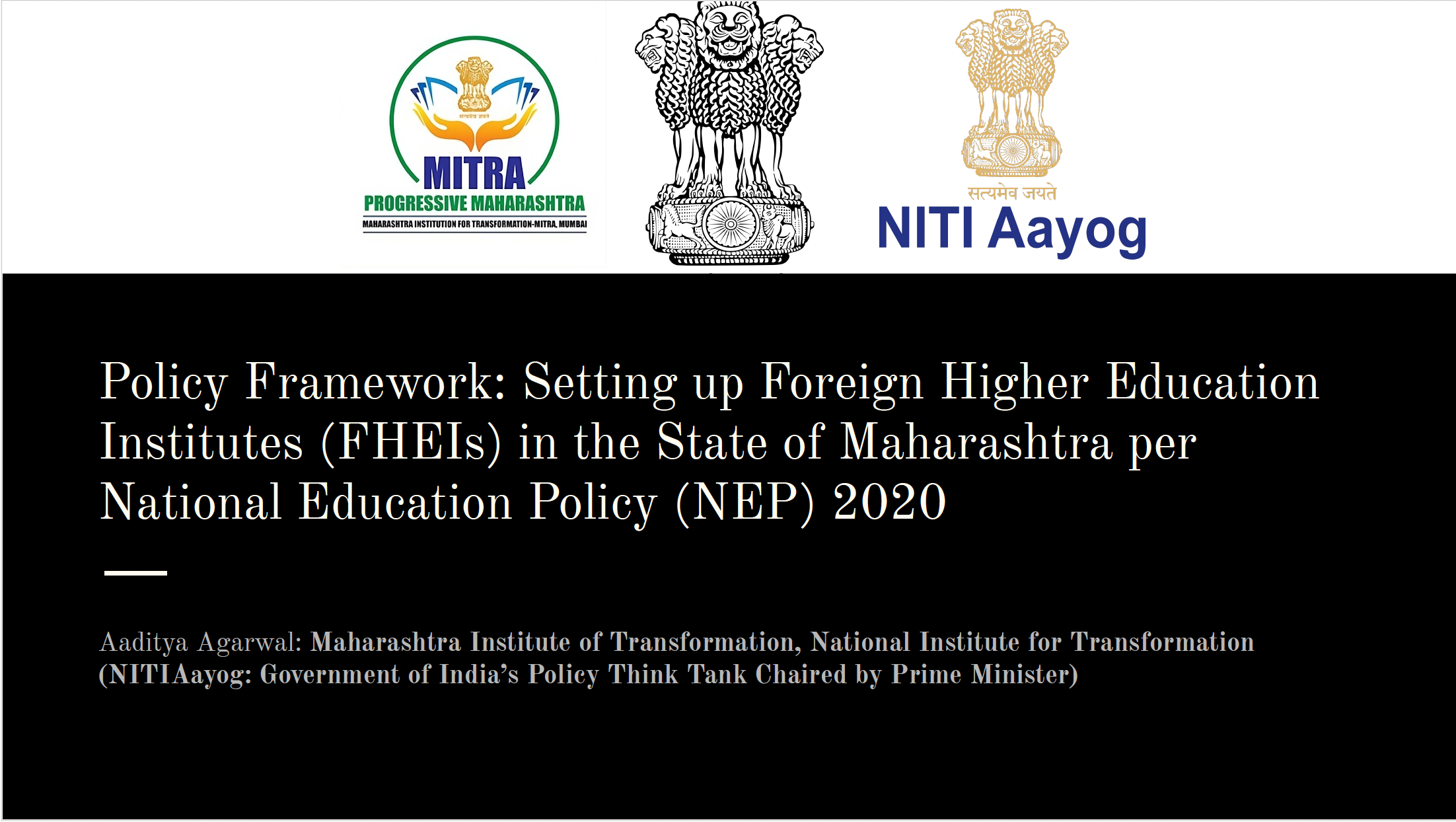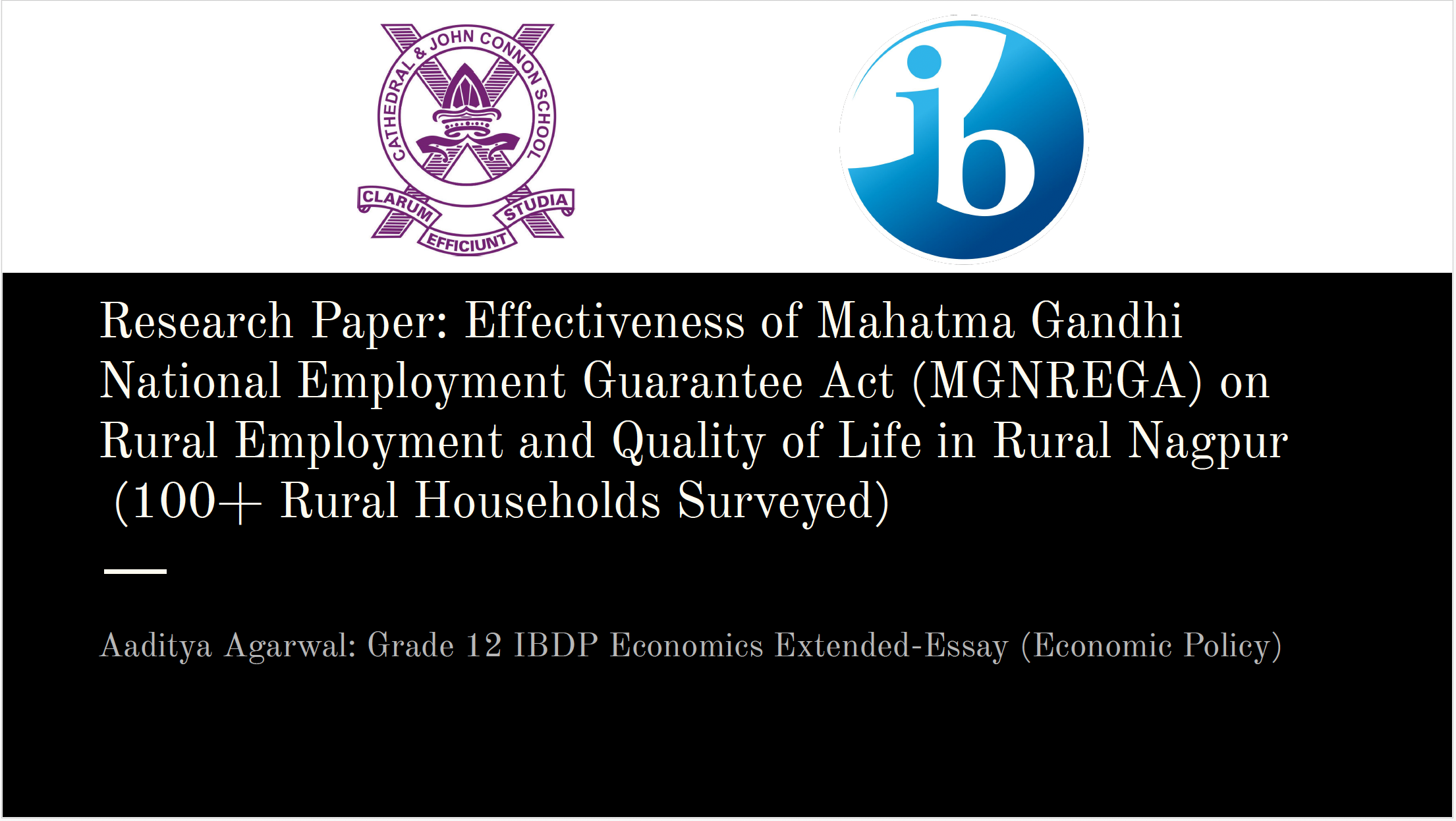Research and Policy Experience
Academic Research & Policy Analysis

Maharashtra Institute of Transformation: Policy Framework to Set up Foreign Higher Education Institutes in India
MITRA Education Policy Intern
As a Higher Education Policy intern at the Maharashtra Institute for Transformation (MITRA), the State's premier policy think tank, I worked on drafting the framework for the setting up of Foreign Higher Education Institutions (FHEIs) in Maharashtra as per the guidelines of the National Education Policy (NEP) 2020. With over 700,000 Indian students studying abroad annually, there is an estimated foreign exchange outflow of $60 billion; thus, this study assesses how the Government of India can provide quality higher education by strengthening domestic institutions and thus reduce brain drain.
Four structural challenges are detected to solve to enable this framework to succeed: unsustainable land costs, arbitrarily high taxation, fragmented government regulation, and inequitable fee and degree structures. Most notably, unsustainably high land prices in hubs such as suburban Mumbai (where it would cost around $149 million to set up a 25 acre campus) and a high tax requirement (comprising a 40% corporate tax, 18% GST, and 6% stamp duty) act as strong deterrents to foreign universities. The lack of effective inter-ministerial coordination and synchronised approval mechanisms further reduces operational efficiency, and rigid fee parity and degree equivalence limit the inclusivity by limiting the benefits of this framework only to higher income earners.
The key policies proposed for the operationalisation of FHEIs in Maharashtra include land subsidies, tax holidays, establishing a Single-Window Maharashtra FHEI Facilitation Authority, tiered tuition models and an expansion of the need-based scholarship system to these FHEIs to facilitate equity. The policy also includes an impact-based evaluative framework to assess each institution's performance on the core metrics of inclusivity, academic quality, pedagogical innovation, research engagement, and community benefit. Through the proposed policy framework along with continuous-assessment, Maharashtra will be able to lead as India's leading global education hub by delivering high quality education at an accessible cost.
View Entire Research Abstract
Four structural challenges are detected to solve to enable this framework to succeed: unsustainable land costs, arbitrarily high taxation, fragmented government regulation, and inequitable fee and degree structures. Most notably, unsustainably high land prices in hubs such as suburban Mumbai (where it would cost around $149 million to set up a 25 acre campus) and a high tax requirement (comprising a 40% corporate tax, 18% GST, and 6% stamp duty) act as strong deterrents to foreign universities. The lack of effective inter-ministerial coordination and synchronised approval mechanisms further reduces operational efficiency, and rigid fee parity and degree equivalence limit the inclusivity by limiting the benefits of this framework only to higher income earners.
The key policies proposed for the operationalisation of FHEIs in Maharashtra include land subsidies, tax holidays, establishing a Single-Window Maharashtra FHEI Facilitation Authority, tiered tuition models and an expansion of the need-based scholarship system to these FHEIs to facilitate equity. The policy also includes an impact-based evaluative framework to assess each institution's performance on the core metrics of inclusivity, academic quality, pedagogical innovation, research engagement, and community benefit. Through the proposed policy framework along with continuous-assessment, Maharashtra will be able to lead as India's leading global education hub by delivering high quality education at an accessible cost.

Economic Policy Research Paper on effectiveness of the Mahatma Gandhi National Rural Guaranteee Employment Act Utilising Primary Data from Rural Nagpur
IB Economics Extended Essay
For my IB Economics Extended Essay on Economic Policy, I evaluated the extent to which the Mahatma Gandhi National Rural Employment Guarantee Act (MGNREGA) has improved rural employment and household income in Nagpur, Maharashtra, between 2021 and 2024. It is hypothesised that, since India is primarily an agrarian economy, MGNREGA's guaranteed 100 days of wage employment bring relief by providing additional income to rural households who otherwise remain dependent on unskilled, insecure jobs in the agricultural off-season. The period of analysis is defined by macroeconomic shocks such as the COVID-19 pandemic, demand-pull inflation, and drought, providing a unique context for assessing the program's effectiveness across multiple scenarios.
The study employs a quantitative approach, using secondary data from the MGNREGA Management Information System (MIS) maintained by the Ministry of Rural Development, complemented by a primary survey of 100 households in rural Nagpur. The analysis focuses on the key indicators of employment generation, the impact of income earned, and unmet work demand, supported by the theoretical frameworks of the labour market, the Keynesian Multiplier, and developmental economics' poverty trap.
In 2021, during the peak of the pandemic, MGNREGA, by generating an average income of ₹10,900 per household, provided crucial support for healthcare and basic consumption. However, in 2022, rural inflation peaked at 6.9% while real wages rose only by 3.2%, revealing the scheme's failure to prevent rural distress. While the 2023 central government budget cuts further reduced total persondays by 19.7% and thus exposed severe shortcomings, the 2024 budget was a drastic improvement for the policy, with persondays increasing by 64.5% YoY and average workdays rising to 50. As real income grew by 4.7%, MGNREGA's role as a macroeconomic shock absorber was evident in 2024. Yet, structural inefficiencies, such as the fact that only 10.6% of households received the statutory 100 workdays, and that yearly unmet demand averaged 11.1%, mean that MGNREGA remains inconsistent in its ability to improve living standards. However, it is important to remember that the ₹11,000–₹15,000 earned annually through the program served as vital income for rural households supporting expenditure on food, education, and healthcare, facilitating short-term rural income security and poverty alleviation in Nagpur, while its long-term effects are unknown.
View Entire Research Abstract
The study employs a quantitative approach, using secondary data from the MGNREGA Management Information System (MIS) maintained by the Ministry of Rural Development, complemented by a primary survey of 100 households in rural Nagpur. The analysis focuses on the key indicators of employment generation, the impact of income earned, and unmet work demand, supported by the theoretical frameworks of the labour market, the Keynesian Multiplier, and developmental economics' poverty trap.
In 2021, during the peak of the pandemic, MGNREGA, by generating an average income of ₹10,900 per household, provided crucial support for healthcare and basic consumption. However, in 2022, rural inflation peaked at 6.9% while real wages rose only by 3.2%, revealing the scheme's failure to prevent rural distress. While the 2023 central government budget cuts further reduced total persondays by 19.7% and thus exposed severe shortcomings, the 2024 budget was a drastic improvement for the policy, with persondays increasing by 64.5% YoY and average workdays rising to 50. As real income grew by 4.7%, MGNREGA's role as a macroeconomic shock absorber was evident in 2024. Yet, structural inefficiencies, such as the fact that only 10.6% of households received the statutory 100 workdays, and that yearly unmet demand averaged 11.1%, mean that MGNREGA remains inconsistent in its ability to improve living standards. However, it is important to remember that the ₹11,000–₹15,000 earned annually through the program served as vital income for rural households supporting expenditure on food, education, and healthcare, facilitating short-term rural income security and poverty alleviation in Nagpur, while its long-term effects are unknown.
Independent Research: Expanding Access of the Indian Higher Education Loan Framework to Lower and Middle-Income Earners
Independent Research Paper
India's higher education system is the largest in the world but currently fails to meet the needs of the majority of the student population. Through this research paper, I aimed to examine the structural shortcomings between government-subsidized education loans offered by Scheduled Commercial Banks (SCBs) under the Indian Banks' Association (IBA) Model Education Loan Scheme and private Non-Banking Financial Companies (NBFCs) driven by profit motives. This paper analyses the current Indian Higher Education Loan Framework on the basis of accessibility, affordability, delivery, and performance.
Although SCBs aim to serve lower-income students through their collateral-free loans, operational inefficiencies and unwillingness to lend large amounts limit their effectiveness. NBFCs, because they lend to premium customers who are less likely to default, display superior asset quality through lower Non-Performing Asset Rates (< 0.5%). However, large-ticket loans from these NBFCs are inaccessible to low- and middle-income students due to their high co-signer and income requirements, and even higher interest rates.
This paper also proposes structural policy reforms to expand access to the higher education framework: from extending government credit guarantees (CGFSEL) and interest subsidies (CSIS) to NBFCs to mandating income-based repayment systems within the Model Education Loan scheme. Further, there is an apparent need to facilitate refinancing of education loans and introduce targeted forgiveness schemes for social workers.
Although SCBs aim to serve lower-income students through their collateral-free loans, operational inefficiencies and unwillingness to lend large amounts limit their effectiveness. NBFCs, because they lend to premium customers who are less likely to default, display superior asset quality through lower Non-Performing Asset Rates (< 0.5%). However, large-ticket loans from these NBFCs are inaccessible to low- and middle-income students due to their high co-signer and income requirements, and even higher interest rates.
This paper also proposes structural policy reforms to expand access to the higher education framework: from extending government credit guarantees (CGFSEL) and interest subsidies (CSIS) to NBFCs to mandating income-based repayment systems within the Model Education Loan scheme. Further, there is an apparent need to facilitate refinancing of education loans and introduce targeted forgiveness schemes for social workers.